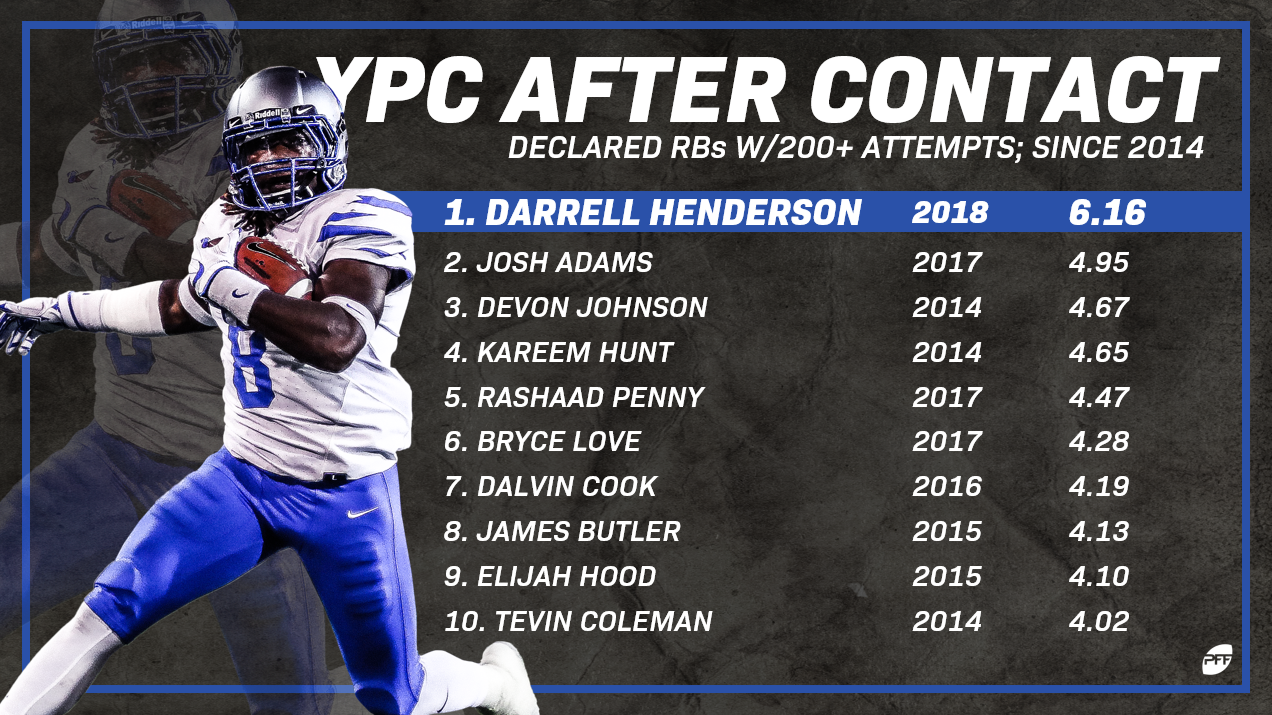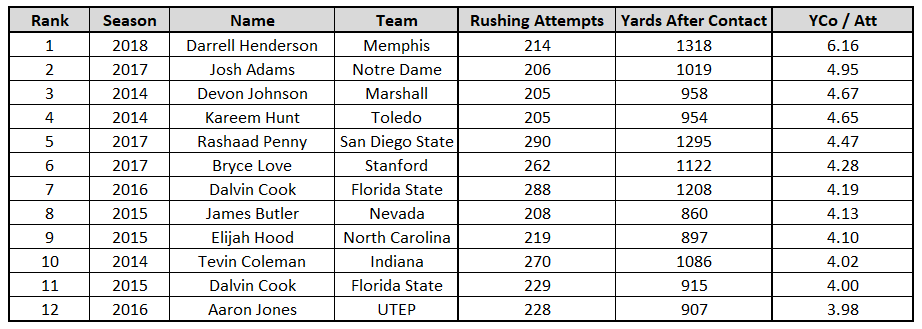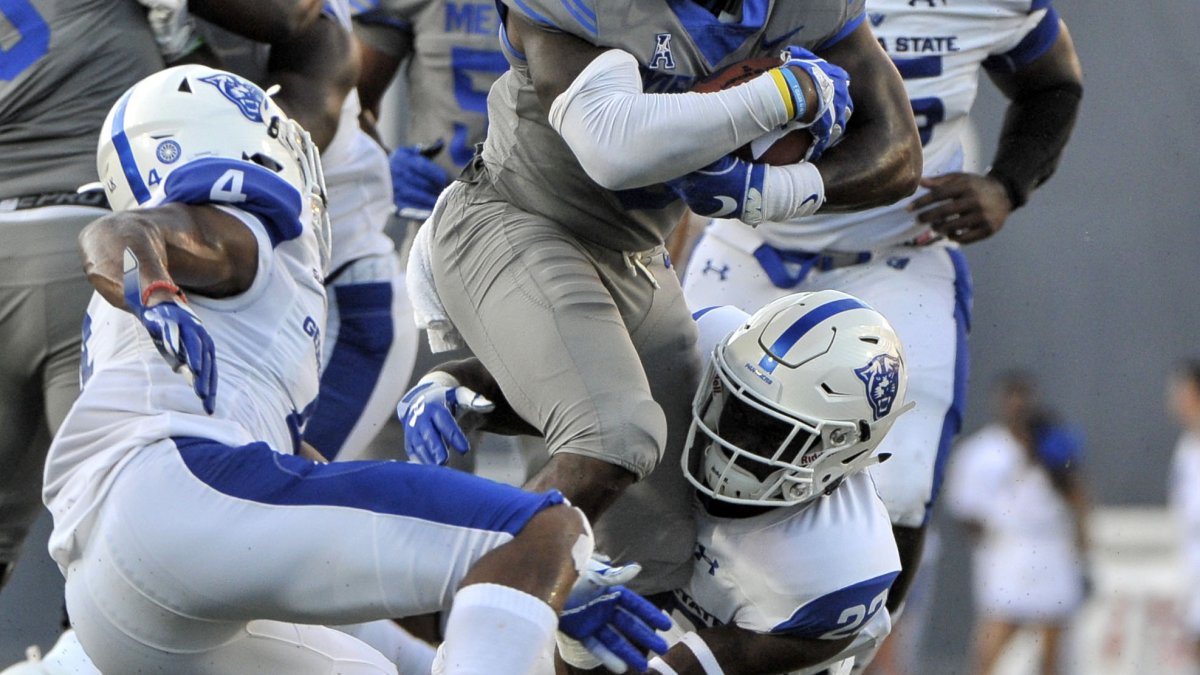Earlier this week, we discussed three incoming rookie running backs who were especially adept at forcing missed tackles at the college level and why that’s encouraging for their fantasy draft stock. Today, we’re doing something similar, only this time looking at running backs who excelled at creating yards after contact.
In our last article, we highlighted David Montgomery, Devin Singletary, and James Williams. Today, our focus turns to Darrell Henderson and (to a lesser extent) Bryce Love.
In 2018, Henderson averaged 8.9 yards per carry, giving him, over Reggie Bush's famed 2005 season (8.7), the most-efficient yards per carry season (min. 200 carries) since at least 2000.
That’s surely an impressive stat on its own, but yards per carry is a stat that’s noisier and less meaningful than yards after contact per attempt. Like missed tackles forced, yards after contact per attempt helps to highlight running back skill level independent of team blocking.

Since 2014 (when PFF first started tracking college players), there are 1,332 instanced of a running back totaling at least 65 carries. Of those 1,332 seasons, Henderson’s 2018 season (on 214 attempts) ranks first in yards after contact per attempt (6.16). His 2017 season (on 128 attempts) ranks second (5.60).
Josh Adams (in 2017) set the previous yards after contact per attempt record (4.95) among all running backs with at least 200 attempts. For perspective, that means Henderson’s 2018 season was 21.8% better than the next-best season on record.
Looking at all college running back seasons since 2014 (min. 200 attempts) and excluding all running backs who have not yet declared for the NFL draft, here are the top-12 (of 220 qualifying) seasons by yards after contact per attempt:

On this list, we have two running backs who are draft-eligible this year (Henderson and Love), as well as a number of fantasy superstars. Kareem Hunt was a first-round fantasy draft pick last year and ranks second-best in PFF grade over the past two seasons. Dalvin Cook will be drafted among the top-12 fantasy running backs this year. Aaron Jones ranks first in yards per carry over the past two seasons (5.50). Rashaad Penny was a first-round NFL draft pick last year. Tevin Coleman is one of only 11 running backs with 2,000 rushing and 1,000 receiving yards over the past four seasons. Adams led the Eagles in rushing yards last season. The only true busts were Elijah Hood (a seventh-round NFL draft pick in 2017), and Devon Johnson and James Butler, who went undrafted.
Clearly, this seems highly encouraging for Henderson’s fantasy draft stock. His final collegiate season ranks best among a number of successful cohorts, and that season was 43.0% better than the 12th-best season in our database.
Still, on a deeper look, there are a number of reasons to be skeptical.
Last season the Memphis Tigers’ offensive line ranked third-best of 137 qualifying teams in PFF run-block grade per rushing attempt. Though they ranked slightly below average in 2017, this still paints Henderson in a less-encouraging light. Remember, yards after contact numbers are meant to dispel an offensive line’s influence from a player’s rushing production. Perhaps Henderson struggled to hit open holes or was often “slow out of the gates,” making his after-contact numbers look better than they appear.
Henderson does not play in a Power-5 conference, and by my data (expected yards per carry based on schedule, explained here) had the softest rushing strength of schedule of any combine-invite running back in both 2017 and 2018. Still, even with that in mind, his yards per carry numbers over expectation were the best in the class.
Henderson is currently the fourth-highest-drafted rookie running back by current best ball ADP, and I think that’s about right. Even with our two caveats in mind, he’s probably one of the five best runners in the class and also has underrated upside as a receiver. Over the past three seasons and among all combine-invite running backs to draw at least 25 targets over this span, he ranks fourth in targets (80), second in receiving yards (758), first in receiving touchdowns (eight), second in yards per target (9.5), second in fantasy points per target (2.34), and first in yards after the catch per reception (15.7).
Love’s 2017 was also impressive in yards after contact per attempt, but his numbers were more underwhelming in 2018, though he did deal with a lingering injury for much of the season. I have Love a few spots below Henderson in my rankings.
Keep an eye on our best ball rankings to know which rookie running backs are the best values by current ADP. We’ll have our dynasty rookie rankings out shortly, which will be heavily influenced by the PFF Draft Guide (out now and continually updated).



 © 2025 PFF - all rights reserved.
© 2025 PFF - all rights reserved.